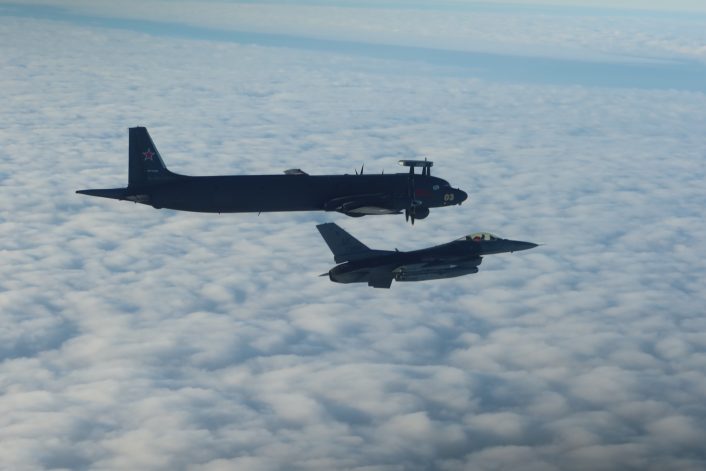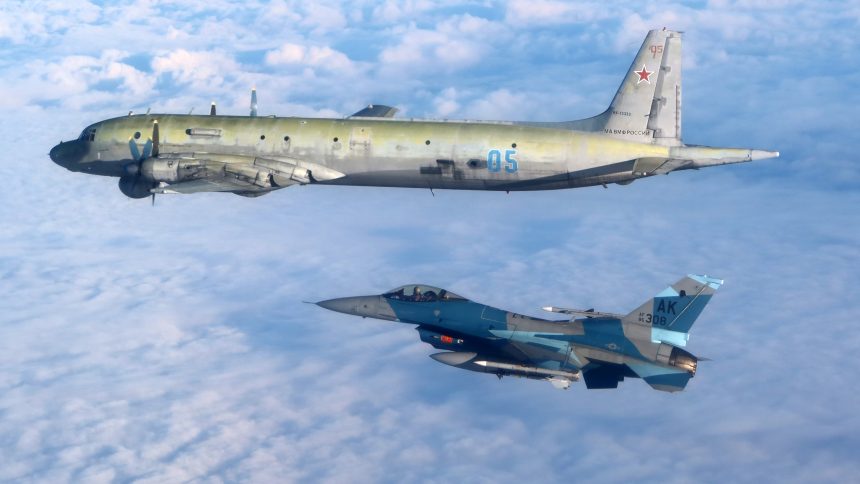As happened in May 2024, F-16 in Russian-inspired camouflage color scheme recently intercepted Russian aircraft off Alaska.
Earlier this month, Russian Navy Il-38 and Il-38N “Dolphin” (NATO codename “May”) Anti-Submarine Warfare (ASW) and Maritime Patrol Aircraft were intercepted by U.S. F-16s under NORAD (North American Aerospace Defense) command over international airspace inside the Alaska Air Defense Identification Zone (ADIZ).
These aircraft, part of Russia’s maritime reconnaissance force, play a critical role in patrolling seas and detecting underwater threats. The Il-38N is a modernized version of the older Il-38, primarily designed for ASW and equipped with advanced detection systems. The Il-38N incorporates state-of-the-art technology, notably the Leninets Novella-P-39, and an advanced sensor suite, which includes a multi-functional radar capable of detecting aerial and surface targets, along with a highly sensitive radio sonobuoy system for underwater monitoring. The aircraft also features a Magnetic Anomaly Detector (MAD) for pinpointing underwater objects like submarines within a 900-meter range. Additionally, an Electro-Optical (EO) turret with a TV, infrared imaging, laser rangefinding, and automated target tracking further enhances its operational efficiency. Electronic Support Measures (ESM) sensors installed in a circular box fairing improve its surveillance capabilities, detecting and tracking electronic emissions from surface ships or aircraft.
The Il-38 and its variants are integral to Russia’s naval operations, capable of providing reconnaissance as well as deploying air-dropped mines.
The Russian Navy’s air-dropped mine inventory includes some of the oldest and newest models, such as the AMD series and the UDM family. These mines are deployed for both defensive and offensive purposes. Mines like the UDM-2 are capable of delivering significant damage to enemy submarines and ships. The interception of these planes serves as a reminder of the strategic importance of patrolling airspace near sensitive maritime zones and the complexities of modern naval warfare, where both underwater and aerial threats must be countered.
Interestingly, the Russian Navy Il-38s have recently carried out an exercise in the Pacific off the coast of Kamchatka, the Russian Ministry of Defense announced on Sept. 16, 2024. According to the Russian MOD, a group of Il-38 anti-submarine aircraft from the mixed aviation regiment of the Troops and Forces in the north-east of Russia laid mines in a sea range.
Four Il-38 and Il-38N aircraft took off from the Yelizovo airfield and laid minefields along the probable routes of the enemy’s landing craft in Avacha Bay. “Four lines of mines were installed at different distances from the shore in possible locations for the landing of marines. More than 50 training mines were dropped by parachute, covering a section of the sea coast about 10 kilometers long. The aircraft were in the air for more than 3 hours, patrolling the coastal areas and the coastline of Kamchatka.”
Aggressor paint scheme
The images of the Il-38s intercepted by NORAD fighters on Sept. 15, 2024, show that at least one of the F-16Cs of the 18th Fighter Interceptor Squadron (FIS), stationed at Eielson Air Force Base, Alaska, scrambled to intercept the Russia aircraft sported a typical aggressors camouflage color scheme and a standard QRA (Quick Reaction Alert) loadout, made of AIM-120D AMRAAM and AIM-9L/M Sidewinder missiles, and a Sniper Advanced Targeting Pod (ATP), that is not visible in the shots.
The unit, formerly 18th Aggressor Squadron, was the USAF’s dedicated Aggressor unit in Alaska, that was redesignated 18th FIS on Feb. 2, 2024, a designation that underscores the unit’s renewed focus on air defense, which has been going for a while now as the 18th AGRS complemented the F-22 in this role with a number of F-16 on Quick Reaction Alert duties since late 2022. This squadron, with a legacy dating back to its formation in 1939, has served various roles, including protecting Alaska during World War II and training for combat missions during the Cold War.

Lt. Col. Albert Roper, commander of the 18th FIS, highlighted the historical significance of the squadron’s reactivation as an air defense unit earlier this year: “We’ve been a pursuit squadron, a fighter squadron, and an aggressor squadron. Now we’re back to a Fighter Interceptor Squadron in the state of Alaska, honoring our history.” Supporting this transformation, the 354th Aircraft Maintenance Squadron was replaced by the 18th Fighter Generation Squadron (FGS), ensuring a seamless link between the squadron’s air defense and maintenance capabilities. Maj. Stephan White, commander of the 18th FGS, explained that this organizational shift enables faster, more agile mission execution by integrating maintenance and flying units.
This is not the first time an F-16 in Russian-like paint scheme intercepted Russian aircraft off Alaska: on May 2, 2024, four Russian military aircraft, including two Tu-95 bombers escorted by an Su-35S and an Su-30SM, were intercepted by an F-16 of the 18th FIS in aggressors camouflage inside the Alaska ADIZ.
Alaska ADIZ
The Russian aircraft escorted by NORAD fighters as part of a routine interception had entered the Air Defense Identification Zone (ADIZ), a buffer airspace where any unidentified aircraft must be tracked and identified. Unlike national airspace, which is sovereign and extends 12 nautical miles beyond a country’s coast, ADIZs are not bound by international law but are critical for national security. Any aircraft entering without proper clearance is subject to interception, as happened with the Russian Il-38s.









